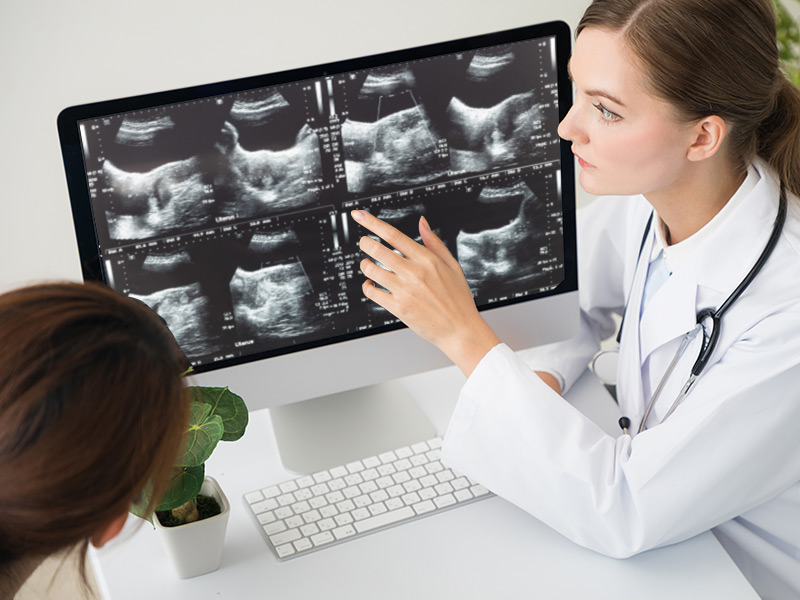Diagnosis & Treatment
Uterine Fibroids
Most uterine fibroids are found during an ob-gyn appointment when your physician completes a routine pelvic exam. A fibroid can be left untreated if it is not causing symptoms, but fibroids that cause symptoms, such as abdominal pain and heavy menstruation, are treatable. Discuss all the treatment options and symptom relief available for fibroids with your doctor.
How are Uterine Fibroids Diagnosed?
Diagnosis
If you have symptoms and signs of uterine fibroids, your doctor will provide an extensive evaluation, a comprehensive diagnosis, and treatment plan. Many fibroid complications can be minimized by addressing them early, as it is much more challenging to manage large fibroids. There are many factors involved in deciding when to pursue diagnosis and treatment, such as the individual's symptoms, the extent and location of the fibroids, and childbearing goals. You may undergo a series of imaging tests to confirm that you have fibroids. These tests may include:
- Ultrasound
- Magnetic resonance imaging (MRI)
- Hysterosalpingogram (HSG), which involves injecting X-ray dye into the uterus and taking X-ray images
- Sonohysterogram, which involves injecting saline into the uterus and taking ultrasound images
You might also need surgery to confirm that you have fibroids. Types of fibroid surgery include:
- Laparoscopy, in which the doctor inserts a long, thin scope into a tiny incision made in or near the navel to view the uterus
- Hysteroscopy, in which the doctor passes a long, thin scope with a light through the vagina and cervix into to view the uterus
Uterine Fibroid Treatments
TreatmentAt NewYork-Presbyterian, our experienced gynecologic surgeons collaborate with skilled providers to deliver the highest level of care before, during, and after fibroid surgery.
If you have symptoms, our physicians will discuss the best way to treat your fibroids based on your health and lifestyle factors. For individuals with uterine fibroids, it's important to get the facts about fibroids. There are many options to address the conditions and improve your quality of life. Fibroid treatment options may include watchful waiting, medications, hormonal therapies, or lifestyle changes to your diet or exercise routine.
Medical therapies
If you have fibroids and have mild symptoms, your doctor may suggest taking medications:
- Over-the-counter drugs such as ibuprofen or acetaminophen can be used for mild pain or cramps
- Hormonal-based therapies can be prescribed to help control fibroids' symptoms, including low-dose birth control pills, progesterone-like injections, and IUD devices containing a small amount of progesterone-like medication can be used to control heavy bleeding as well as for birth control.
- Gonadotropin-releasing hormone agonists (such as Depo-Lupron) are given by injection or Gonadotropic-releasing hormone antagonists (such as Orlissa) are taken orally
Surgical treatments
At NewYork-Presbyterian, our experienced gynecologic surgeons collaborate with our highly skilled staff to provide the highest level of care before, during, and after surgery.
Depending on the type of fibroid and its location, the following surgical treatments may help you:
Laparoscopic Radiofrequency Ablation: Often referred to as the Acessa Procedure®, this is a minimally invasive procedure that uses heat to target fibroids one by one, reducing their size significantly. By shrinking the fibroids, patients enjoy less severe symptoms and a better quality of life.
Transcervical Radiofrequency Ablation: Uses a miniaturized ultrasound probe to reduce the fibroids' size from inside the uterus with high-energy waves. This minimally invasive, incision-free method allows doctors to treat fibroids and preserve the uterus and fertility. It also may give them the option of having vaginal childbirth in the future.
Interventional vascular treatment: If fertility is not an issue, some patients can opt for uterine fibroid embolization, in which particles are delivered through a catheter inserted in the groin or wrist and guided into the blood vessels that feed fibroids to cut off their blood supply and cause them to shrink.
Myomectomy: Surgery to remove fibroids without removing the healthy tissue of the uterus, which may be performed using minimally invasive surgery depending upon the location of the fibroids. These procedures may include robotic or laparoscopic myomectomy (through several tiny incisions in the abdomen) or hysteroscopic myomectomy (through the vagina and cervix).
Hysterectomy: Surgery to remove the entire uterus is the only sure way to cure fibroids, which may be performed by a minimally invasive approach even for larger fibroids.
Long-term management
Our team of fibroid specialists is committed to giving patients with uterine fibroids comprehensive, ongoing care to live the best quality of life. Your long-term care may include periodic evaluations to review your symptoms and monitor the fibroid with abdominal and pelvic examinations depending on your individual needs. Fibroids are likely to grow until a patient reaches menopause, and treatments can be offered throughout their lifetime.
This content has been reviewed by the following medical editors.
Get Personalized Uterine Fibroid Care at NewYork-Presbyterian
NewYork-Presbyterian offers high-quality care for patients with uterine fibroids, utilizing the latest fibroid treatment approaches with advanced technology and innovative techniques. Understand the symptoms and causes of fibroids to improve your quality of life and gynecological health. Learn the facts about uterine fibroids and the various options available to decide the best course of treatment.
Find out more about how to treat uterine fibroids and improve your health and wellbeing. Contact us today to make an appointment.



